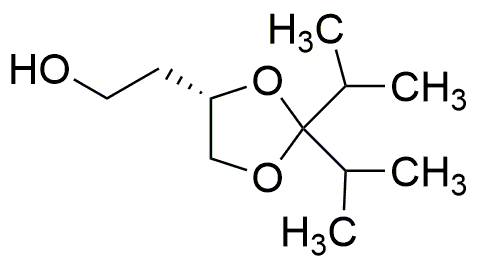(S)-4-(2-Hydroxyethyl)-2,2-diisopropyl-1,3-dioxolane is widely utilized in research focused on:
- Pharmaceutical Development: This compound serves as an important intermediate in the synthesis of various pharmaceuticals, enhancing the efficiency of drug formulation processes.
- Chiral Catalysis: Its chiral properties make it valuable in asymmetric synthesis, allowing researchers to produce specific enantiomers that are crucial in drug efficacy.
- Solvent Applications: It acts as a solvent in chemical reactions, providing a stable environment that can improve reaction yields and purity.
- Polymer Chemistry: The compound is used in the development of specialty polymers, contributing to materials with enhanced properties for applications in coatings and adhesives.
- Biochemical Research: It is utilized in studies involving enzyme interactions and metabolic pathways, aiding in the understanding of biological processes.
General Information
Properties
Safety and Regulations
Applications
(S)-4-(2-Hydroxyethyl)-2,2-diisopropyl-1,3-dioxolane is widely utilized in research focused on:
- Pharmaceutical Development: This compound serves as an important intermediate in the synthesis of various pharmaceuticals, enhancing the efficiency of drug formulation processes.
- Chiral Catalysis: Its chiral properties make it valuable in asymmetric synthesis, allowing researchers to produce specific enantiomers that are crucial in drug efficacy.
- Solvent Applications: It acts as a solvent in chemical reactions, providing a stable environment that can improve reaction yields and purity.
- Polymer Chemistry: The compound is used in the development of specialty polymers, contributing to materials with enhanced properties for applications in coatings and adhesives.
- Biochemical Research: It is utilized in studies involving enzyme interactions and metabolic pathways, aiding in the understanding of biological processes.
Documents
Safety Data Sheets (SDS)
The SDS provides comprehensive safety information on handling, storage, and disposal of the product.
Product Specification (PS)
The PS provides a comprehensive breakdown of the product’s properties, including chemical composition, physical state, purity, and storage requirements. It also details acceptable quality ranges and the product's intended applications.
Certificates of Analysis (COA)
Search for Certificates of Analysis (COA) by entering the products Lot Number. Lot and Batch Numbers can be found on a product’s label following the words ‘Lot’ or ‘Batch’.
*Catalog Number
*Lot Number
Certificates Of Origin (COO)
This COO confirms the country where the product was manufactured, and also details the materials and components used in it and whether it is derived from natural, synthetic, or other specific sources. This certificate may be required for customs, trade, and regulatory compliance.
*Catalog Number
*Lot Number
Safety Data Sheets (SDS)
The SDS provides comprehensive safety information on handling, storage, and disposal of the product.
DownloadProduct Specification (PS)
The PS provides a comprehensive breakdown of the product’s properties, including chemical composition, physical state, purity, and storage requirements. It also details acceptable quality ranges and the product's intended applications.
DownloadCertificates of Analysis (COA)
Search for Certificates of Analysis (COA) by entering the products Lot Number. Lot and Batch Numbers can be found on a product’s label following the words ‘Lot’ or ‘Batch’.
*Catalog Number
*Lot Number
Certificates Of Origin (COO)
This COO confirms the country where the product was manufactured, and also details the materials and components used in it and whether it is derived from natural, synthetic, or other specific sources. This certificate may be required for customs, trade, and regulatory compliance.


